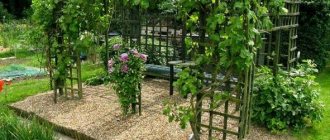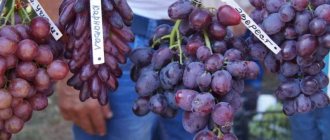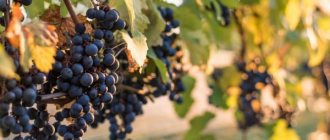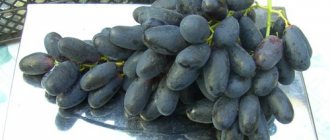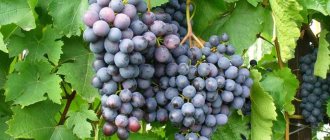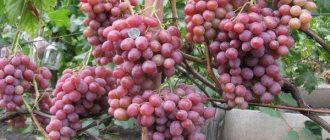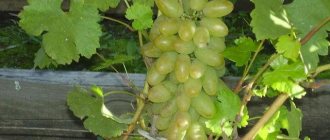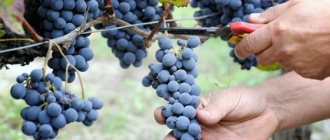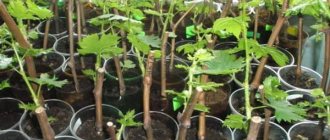(? x Heinisch Weiss) Synonyms: White Riesling, Gewuerztraube, Graschevina (Graschevina, Grasevina Rajnska, Biela Grasevina), Lipka, Moselriesling, Kleiner Riesling (Kleiner Riesling, Kleinriesler, Kleinriesling), Netherlands ( Niederlaender), Rheinriesling, Oberkircher, Petit Riesling, Riesling, Rhine Riesling and many others. Riesling is a technical grape variety discovered on the banks of the Rhine River. Based on morphological characteristics and biological properties, Riesling belongs to the ecological and geographical group of Western European grape varieties. It is widespread in many wine-growing countries of the world - Germany, Austria, Bulgaria, Hungary, Yugoslavia, Czech Republic, Romania, Switzerland, USA, Argentina, etc. The crown of the young shoot is covered with sparse felt pubescence of a light green color with pink teeth, the leaves are light green with bronze tint. One-year-old mature shoot is light brown, darker at the nodes. The leaf is medium-sized, round, medium- and deeply dissected, 3- or 5-lobed, folded-funnel-shaped, coarsely wrinkled. The upper cuts are of medium depth, closed, with an oval lumen or open, lyre-shaped, the lower ones are shallow, open. The petiole notch is open, lyre-shaped and closed, with a narrow elliptical lumen. The teeth at the ends of the blades are triangular. The marginal denticles are broadly triangular, almost dome-shaped. The pubescence of the lower surface of the leaf is cobwebby with sparse bristles on the veins. The flower is bisexual. The bunch is small or medium in size (8-14 cm long, 6-8 cm wide), often cylindrical, sometimes cylindrical-conical, dense and loose. The stem of the grape bunch is short - up to 3 cm long. The average weight of the bunch is 80-100 g. The berry is medium-sized (11-15 mm in diameter), round, greenish-white with a yellowish tint and rare, small, dark brown dots. The skin is thin and very durable. The pulp is juicy, the taste is harmonious and pleasant. The average weight of 100 berries is 120-140 g. There are 2-4 seeds per berry.
Italian Riesling
Synonyms: Biela Sladka, Biela Sladka Grasica, Biela Sladka Grassica, Bielasladka Grasica, Borba, Borba Blanca, Welschriesling, Grasevina, Grasevina Bijela, Grasevina Italijanska, Grasevina Talijanska, Grashevina Grasica, Laski Riesling, Laski Rizling, Laskirizling, Olas Riesling (Olasriesling, Olasz Risling, Olasz Rizling, Olasz Rizlingi), Rizling Vlassky, Talianska Grasevina, Talijanska Grasevina, etc. Italian Riesling ( Rizling Italico, Rizling Italien, Rizling Italien Blanc, Rizling Italjanskij, Rizling Italsky) is a technical grape variety that belongs to the Western European ecological and geographical group of grape varieties.
Cultivated in the Balkans, Hungary, Austria, Yugoslavia, Romania, Italy. The crown of the young shoot and the first two leaves are heavily pubescent. The one-year-old mature shoot is yellowish-brown, the nodes on it are almost indistinguishable. The grape leaf is medium-sized, ovate, 3- and 5-lobed, deeply dissected. The upper notches are deep, open, lyre-shaped, sometimes closed, of medium depth, with an ovoid lumen, the lower ones are small, in the form of a reentrant angle. The petiole notch is open, lyre-shaped and vaulted. The teeth at the ends of the blades are narrowly triangular, the teeth along the edge are saw-toothed, sharp, lighter in color, they seem to border the leaf with a yellowish stripe. The lower surface of the leaf has cobwebby pubescence. The flower is bisexual. The cluster is of medium size (12-16 cm long, 7-10 cm wide), cylindrical and cylindrical-conical, often winged, dense. The stalk of the bunch is of medium length - up to 5 cm. The weight of the bunch is 94 g. The berry is small or medium in size (11-16 mm long, 11-15 mm wide), round, light green, covered with dark dots. The skin is strong, the flesh is very juicy. There are 3-4 seeds in a berry. Leading characteristics of the Italian Riesling grape variety : thin leafy shoots; small, smooth, yellowish-edged leaves with pointed teeth; cylindrical, very dense clusters on longer stems than Rhine Riesling; small light green berries. The seedlings have a semi-spreading bush shape. The apex is slightly pubescent, lemon-colored. The leaf is asymmetrical, with a well-defined chlorotic border. Autumn leaf color is yellow-brown.
Growing season . In Odessa, 148 days pass from bud break to ripeness of the berries, with a total of active temperatures of 2890 °C. The ripeness of grape berries occurs in the third ten days of September. Bushes of medium vigor. The variety is characterized by early and good ripening of shoots (80-95%). Productivity is high. The percentage of fruitful shoots is 65-80, the number of bunches on a developed shoot is 0.7-1.5, on a fruitful shoot 2-4. The grape variety is prone to bearing fruit on shoots.
Sustainability . The variety is moderately affected by mildew, and severely affected by gray rot of berries and spider mites. Not resistant to phylloxera. Relatively resistant to winter frosts. It is little susceptible to the harmful effects of spring frosts due to late bud opening. In conditions of lack of moisture and at high temperatures, acidity quickly decreases, which deteriorates the quality of wine materials.
Features of agricultural technology. With a fan-shaped multi-armed design, it is advisable to leave 8-9 eyes when trimming. In the southern wine-growing regions, the grape variety is cultivated on a high trunk (1.2 m). The third most important variety in Austria - 8% of vineyards, 5,000 hectares.
Riesling grape variety
Riesling is a classic ancient European grape variety, which is usually understood as Rhine Riesling, although there is also a much less common R. Italiana. He was born many centuries ago in the Rhineland region of what is now Germany. The first documentary mention of it dates back to 1435. As modern DNA research has shown, the famous variety came from a currently little-known variety of Gouais blanc and a hybrid form of Traminer with wild grapes.
Currently, our hero is widely cultivated primarily in Germany and France, but significant plantations also exist in Austria, Hungary, Serbia, the Czech Republic, Slovakia, Croatia, Italy, Australia, New Zealand, South Africa, the USA and Canada. In general, in terms of distribution in the world, it is among the second ten varieties, but in terms of the quality of the drinks produced, it can compete with the most famous light-colored varieties - Chardonnay and Sauvignon.
Riesling is traditionally used to make wonderful dry, semi-dry, dessert and sparkling wines. It is considered one of the most “terroir” forms of grapes, along with Pinot Noir, which means that the character of the wines changes dramatically, depending on the soil and climatic conditions of the region where the crop grows. In cool climates (such as many German wine regions), the wines have apple notes and a noticeable level of acidity, which is sometimes balanced by residual sugar. In warmer regions, with a later harvest, the wine develops more citrus and peach notes. In some countries, the characteristic chalky tones in this type of drink are often noted. And even in the same place where grapes grow, the bouquet of the finished drink can differ significantly from season to season.
Information from history
The official history of this wine begins in the 18th century, with the ancient Fulda Abbey and Johannesberg Monastery, with its adjacent vineyard.
It is believed that the appearance of this variety dates back to the 9th century AD. There are no official data, since at that time Germany was constantly in a state of internecine wars.
Agrobiological characteristics
The bushes have high growth vigor. The crown of the shoot is covered with moderately dense felt-type pubescence, colored light green; pink areas can be seen on the edges of the denticles. Young leaves have a bronze tint. A standard leaf of medium size, round in shape, three- or five-lobed, not cut too deeply. The leaf surface is rough, heavily wrinkled, with veins convex on the underside and cobwebby pubescence. The profile of the leaf blade is funnel-shaped. The upper side cuts are medium in depth, open lyre-shaped with a rounded bottom or closed with an oval opening. The lower notches are very small, U-shaped or barely outlined. The petiole notch is closed with a narrow elliptical lumen, or open with a narrow mouth. The petioles are usually no longer than the main vein of the leaf and are distinguished by their wine-red color due to the significant presence of anthocyanins. The teeth along the edge of the leaf blade are triangular with wide bases, transitional to dome-shaped. The flowers of the variety are bisexual, but this fact does not save our hero from picking berries, and the buds themselves and even the ovary are prone to shedding. The vine ripens quite well, changing color from reddish to light brown. The nodes are traditionally darker than the internodes. The leaves of the grapes turn yellow before falling in the fall.
Article on the topic: Plant respiration - Modern ideas about the nature of molecular mechanisms and pathways of energy exchange in green plants
Ripening Riesling clusters are small in size, reaching a length of 14 cm and a width of 8 cm. Their structure can be either loose or quite dense, and their shape is cylindrical or cylindrical-conical. The usual weight of a brush is usually 80-100 grams. The comb does not exceed 3 cm in length. The berries are medium-sized, round, 12-14 mm in diameter, colored greenish-white with a yellowish tint in good lighting. The surface of the grapes is covered with sparse dark brown dots and a noticeable protective waxy coating of light colors. The weight of the berry ranges from 1.2−1.4 grams. The pulp of the fruit is very juicy with a harmonious, pleasant taste, without sharp shades in the aroma. The sugar content of the juice of this variety reaches 18−21 g/100 cubic meters. cm, the testable acidity is slightly increased to 8.5−10.5 g/cubic dm. The skin is thin, but very durable. The seeds are small, numbering from 2 to 4 per berry. During processing, the yield of juice from the total mass of the crop exceeds 80%, which is an excellent indicator. The ridges make up 6−7%, the skin 8−9%, the seeds 3−4%.
Our hero is a magnificent and technologically very versatile grape. It is used to make wines with varying levels of sugar content, but its acidity always remains quite high. This circumstance makes it suitable for long-term aging. Sweet Riesling wines are especially suitable for this process, as the high sugar content provides additional preservation. At the same time, there are known cases where high-quality dry or semi-dry wine from this variety not only did not lose its properties, but also amazed tasters with its quality at an age exceeding 100 years. The town hall of Bremen, Germany, houses various wines, including drinks from our hero, dating back to the 17th century. More common aging periods for this variety are 5-15 years for dry, 10-20 years for semi-sweet and 10-30 years for sweet versions. In aged drinks, a distinctive feature is the appearance in the bouquet of mineral tones associated with the smell of gasoline or oil. For this specificity, some consumers do not like aged Riesling.
The most expensive wines from this variety are dessert drinks from the late harvest, which are produced by allowing the grapes to hang on the vines much longer than usual. As a result of evaporation caused by the fungus Botrytis cinerea (“noble rot”), part of the moisture from the berries is removed, and the concentrated drink obtained from them can surprise the most fastidious gourmets with the richness of its taste and aroma.
The usual ripening period for Riesling in the traditional wine-growing regions of our country is considered to be the end of September. The duration of the growing season at this point is 150−160 days, and the sum of active temperatures is 2850−2950°C. The frost resistance of our hero is relatively high for a purebred representative of noble European grapes. In this regard, it is often cultivated on a high (about 1.2 meters) trunk with freely hanging or vertically tied annual growth. If it is necessary to cover the bushes for the winter, use standardless multi-arm fan formations, or patterns based on the principle of an oblique cordon.
The yield of the variety is not outstanding - 70-90 centners of bunches are obtained per hectare of vineyard, and only in the most favorable seasons, with good care, productivity can exceed 10 t/ha. The percentage of fruitful shoots in plants is usually 85−90%, the fruiting coefficient is 1.2−1.6, and the fruiting coefficient is 1.6−2.0. An important and very useful feature is the late blooming of buds in the spring, due to which Riesling is rarely damaged by late spring frosts. In addition, up to 45% of its replacement buds turn out to be fertile. To prevent plants from being overloaded with shoots and harvest, careful spring pruning and subsequent cutting off of barren vines is sufficient. The fruit shoots of the grapes are shortened moderately, leaving about 6-8 eyes on them.
The variety is not resistant to diseases. It is especially damaged by gray rot in wet weather. Somewhat weaker - oidium and bacterial cancer. It has some resistance to mildew. In accordance with this, a strategy for its protection must be built, which will require multiple treatments using contact and systemic chemicals. Resistance to root phylloxera is also low, and therefore planting in most growing regions is carried out with grafted seedlings resistant to the pest. Recommended rootstocks are Berlandieri x Riparia Cober 5BB, Riparia x Rupestris 101−14 or Riparia x Rupestris 3309. The best soil and climatic conditions for planting grapes are considered to be gentle slopes with warm exposures and soils with a high lime content.
Rhine Riesling grapes - variety description and characteristics
The variety is intended for producing white wines and is characterized as technical, not table. It is one of the most popular among winemakers. Other names for the variety: Riesling, Reisling and Riesling Rhenish . It is actively cultivated in most European countries, including Switzerland, and is also popular in Argentina and the USA. Wines made from Riesling grapes are of high quality.
Related article: Experimental studies of the possibility of forming genetic diversity in the Vitaceae grape family in the process of natural evolution
conclusions
- Riesling and Delight grapes are varieties that are suitable for growing in cool climates and do not tolerate heat.
- The plant is not resistant to diseases and pests, so it needs regular treatment.
- The industrial purpose of the variety is technical, but its high taste when grown in a garden allows Riesling to be consumed as a dessert grape.
- The variety is low-yielding.
- The plant is frost-resistant and does not suffer from return frosts.
Properties
The properties of white grapes differ significantly from dark varieties, and Riesling is no exception. Having a technical purpose, it can be used, if desired, as a dessert, but only if it is fully ripened in favorable weather. Read this article on how to grow grapes from seed.
Calorie content
Calorie content of berries 43kcal/100g.a
Benefits and harms
Green grape varieties, including Riesling, have a beneficial effect on the heart and prevent the appearance of malignant tumors. The main value is the catechins contained in the berries, which improve the health of the body as a whole. Also, eating ripe grapes helps prevent the following diseases:
- Alzheimer's disease;
- ischemia of the heart and brain;
- disturbances in the functioning of the nervous system.
To improve the health of the body, it is enough to eat 100 g of grapes per day.
There are particularities regarding the consumption of grapes by people with diabetes. The glycemic index of Riesling berries is 45. It is not recommended for diabetics without certain restrictions. At the same time, if no more than 50 g of berries are consumed per day, there will be no harm if the patient’s condition is satisfactory. Read about the benefits and harms of Moldova grapes at this link.
A negative effect from eating Riesling grapes is possible only if it is eaten in excessive quantities - more than 500 g per day. It is also not recommended to eat it during exacerbations of gastrointestinal diseases. If you are obese, grapes are eaten in minimal quantities.
Acidity
Average sugar content 20%. Average acidity up to 11 g/l.
Combination with various products
Everyone knows that the right choice of wines for various dishes has a positive effect on the taste of food, and food emphasizes the taste properties of wine.
For example, dry white Riesling wine is ideal for fish dishes, dark meat, salads, poultry, and serves as an excellent aperitif.
Sparkling Riesling wine goes well with shellfish and crustaceans, and various types of smoked fish.
Characteristics of the bush
The characteristics of the plant are attractive both for those involved in professional cultivation of grapes for wine production, and for amateur gardeners who are interested in obtaining fruits for fresh consumption.
The bush is vigorous, actively branching. The foliage is good. The leaves are thick, five-lobed. The leaf blades have a shallow dissection, are slightly pubescent, their upper side is intensely wrinkled. The color of adult leaves is light green, young leaves are bronze. They open late, which is why the plant is characterized by increased frost resistance and does not suffer from return frosts. Young shoots are thin, green in color, branched.
Vine flowers are bisexual. They fall off quite quickly, which is why, with a lack of pollinators, the harvest is not high. With high-quality pollination, after flowering, a bunch of small green berries is formed, which, under favorable weather conditions, will fully develop.
The plant's resistance to most major diseases is not high. The variety is less susceptible than others only to mildew, a problem that appears in wet weather.
The Riesling vine is one-year old and small. Well ripened. It has a cylindrical shape and a light brown color. The woody leg is short up to 14 cm.
Bunch
The weight of one bunch is about 100 g. About 70-80 berries are collected in a brush. They fit tightly together and are not prone to rotting. The bunch of berries has a short stalk up to 3 cm long.
The taste of the grapes is rich. They are sweet and juicy with a characteristic smell. The berries ripen in 5-6 months, depending on weather conditions and the region of growth. Harvest occurs at the end of September.
The berries are not large - about 15 mm in diameter. The Preobrazhenie variety has large berries. The shape of the grapes is round, in rare cases slightly elongated. The color is white-greenish or golden. As the berries ripen, their characteristic brown spots appear. The skin of the grapes is thin and at the same time quite dense, ensuring high transportability of the crop. There are from 2 to 4 seeds in berries.
Productivity
The yield of the variety is not high, since clusters are formed on only 87% of shoots, and there is an average of 1.6 clusters per shoot. If the culture is not standard, then on average there are 1.2 bunches per shoot.
If the harvest is abundant, but the vine is very poorly developed, this indicates its imminent death. The plant tries to preserve its appearance with an abundance of seeds.
Reviews from winegrowers
The leading characteristics of the variety that allow gardeners to distinguish Riesling grapes from duplicates are:
- the presence of funnel-shaped, rough, large wrinkled leaves with convex veins on the underside;
- the formation of green-yellow, with a slight bluish tint, berries that have a specific varietal flavor.
Winegrowers rarely prefer Riesling grapes as the only variety in their home vineyard. You should not be afraid of weak resistance to disease. In most cases, preventive measures for treating bushes are standard and largely depend on the agricultural background at the cultivation site.
Growing
The life of a plant and the quality of the resulting harvest directly depend on how correctly it is grown. For seedlings, it is necessary to select a suitable site that meets all the requirements. A special feature of the Riesling variety is that if it is grown in a hot climate, the quality of the fruit drops sharply, which negatively affects the taste of the wine. This grape needs cool weather, similar to that found in its homeland in Germany.
With proper planting and proper care, the vineyard can bear fruit for up to 50 years.
Planting period
Planting is carried out in spring or autumn. The main condition is that the air temperature at this moment does not exceed +15 o. If the area experiences very cold winters, it is better to plant plants in the spring so that they have the opportunity to fully take root and not freeze. Read about planting and caring for virgin grapes here.
When planting, it is necessary to maintain a distance of 120 cm between seedlings. The distance between rows should be 3 m. With this scheme, the development of the vine takes up to 10 years, and the vineyard’s yield will be maximum.
A planting site needs light shade and no strong wind. The soil requires somewhat poor limestone. This will allow you to get berries with the maximum content of nutrients. The soil should be constantly moist, but not swampy and well ventilated. The ideal place to create a professional vineyard is a rocky slope.
Related article: Chile: Global production of new grape variety INIA Grape-One increases
Plants are planted in trenches 70 cm deep. In a garden plot, planting is carried out in holes with a diameter of 60 cm and a depth of 70 cm. A layer of nutritious soil (10 cm deep) is poured into the trench or hole, from which a mound is formed. The seedling is placed on its top, and the roots are distributed along the slopes. The plant is covered with soil, which is then compacted around the trunk. After planting, the grapes are watered with warm water. Then, until complete rooting, it is necessary to water the plantings every 14 days.
Seedlings must be completely healthy and free of mechanical damage.
The best seedlings are 20 cm high and have well-developed, not overdried roots. There must be at least 5 buds on the top shoot. Immediately before planting, the ends of the roots are slightly trimmed. Then for 10 minutes the root is placed in a solution of root growth stimulator or succinic acid.
If the seedlings are planted in the spring, the first harvest can be harvested within a year. When the plant is planted in autumn, it bears fruit from the age of 3. The first harvests are modest. If the winters are very harsh, then fruiting may be delayed for another year. Find out about the Cabernet Sauvignon grape variety here.
Ripening time
From the moment the buds open until the harvest takes place from 140 to 160 days. At the end of September, characteristic brown spots appear on the berries, which indicate ripeness. Read about grafting grapes in spring in this material.
Proper care prevents the occurrence of many diseases in the plant and ensures maximum yield. Agricultural technology when growing vines for the current season comes down to timely watering, fertilizing, pruning and weeding.
Adult plants are watered abundantly at the root 2 weeks before flowering. If the weather is humid, then watering is not required. Also, you should not water the bushes during the period of active development of young shoots. In areas with an arid climate, the vineyard should be watered 3 times per season: 2 weeks before flowering, at the time of active filling of berries and 2 weeks before frost . When watering, you should try not to wet the leaves of the grapes, as this can provoke the appearance of diseases.
Fertilizing is carried out once during the rooting period of seedlings. To do this, after loosening the ground and removing weeds, scatter wood ash around the plants. When watering and during rain, it will penetrate the soil and nourish the seedlings. 4 years after planting Riesling, mandatory fertilizing is carried out, without which fruiting will become insufficient. Ash is also used for it.
Weeds must be removed as soon as they are noticed in the vineyard. After weeding, you need to immediately loosen the soil, which will ensure good root respiration, which is necessary for the full development of the vine.
Disease Prevention
The Riesling variety is not resistant to bacterial cancer, powdery mildew and gray rot. Among the pests, the variety is often affected by grape budworm and phylloxera. Prevention allows them to prevent damage. It is extremely difficult, and sometimes impossible, to exterminate pests and cure plants if they are sick.
Strong plants suffer less from diseases, and therefore it is necessary to constantly properly care for the grapes and cover them for the winter, despite their increased frost resistance. Also, you should not leave organic waste on the site after pruning or weeding. They become a haven for pests. Also, water begins to accumulate in them after rains, and due to increased dampness, fungi develop. The use of medicine against fungal infections of grapes gives results only if the infection is not abundant. Treatment, if the disease does not spread, is recommended to be carried out in the spring or autumn after harvesting, and in case of rapid spread of the disease - at any time. However, after this, due to the use of special drugs, the berries cannot be eaten.
Treatment of plantings against pests should be carried out annually, until the buds open. If the risk of plant damage is very high, then repeated treatment is carried out after the leaves open, but before flowering, so that the chemical compounds do not get into the ovary.
Wasps love the berries, and to protect the crop from insects, you need to use special bags that are placed on the bunches. Hanging baits that contain honey syrup with added toxic substances also help.
The use of any chemicals after the ovary begins to form, otherwise it will be impossible to eat the grapes.
Trimming
Pruning the plant is required so that it branches more actively and at the same time does not become thickened. If grape bushes are not pruned, they quickly reduce their yield, and the berries become smaller and become sour.
Pruning is carried out a year after planting. In the spring, the plants are inspected, and if they are strong and not frozen, then 2-4 buds are cut from each branch. When pruning, the bush is shaped in such a way that it is as convenient to care for as possible. Formation ends after 6 years, when the plants have already taken their final form. From this moment on, the pruning rules change.
On mature grape bushes, only annual growths and weak shoots that will not survive the winter are cut off in the fall. In the spring, after it becomes clear which part of the plant is alive, dry and frozen shoots are cut off. If only the top is frozen, then it is cut off to the first healthy bud. If a thick branch is cut, the cut site should be covered with varnish to reduce the risk of infection and prevent weakening of the plant due to loss of sap.
Landing
When planting Riesling grapes, special attention is paid to several factors:
- illumination Plants of this variety do not like bright sun, but also do not like shaded areas. They do not grow well in extreme heat, preferring moderate lighting, comfortable daytime warmth and cool nights;
- soil. Riesling grapes do not tolerate fertile, loose soils. It grows well in the poor soils of rocky slopes. The poorer the soil, the higher the yields and the better the quality of the fruit.
Grapes are planted either in the spring, when the soil warms up, or in the fall, before the onset of cold weather. The prepared area is dug up and holes are made at a distance of at least 3 meters from each other. The seedlings are planted in a trench measuring 60 x 70. Fertilizers mixed with soil are placed at the bottom, the seedling is placed on this mixture, the roots are straightened, filled halfway with soil, compacted and watered. As soon as the water is absorbed into the ground, the hole is completely filled up.


